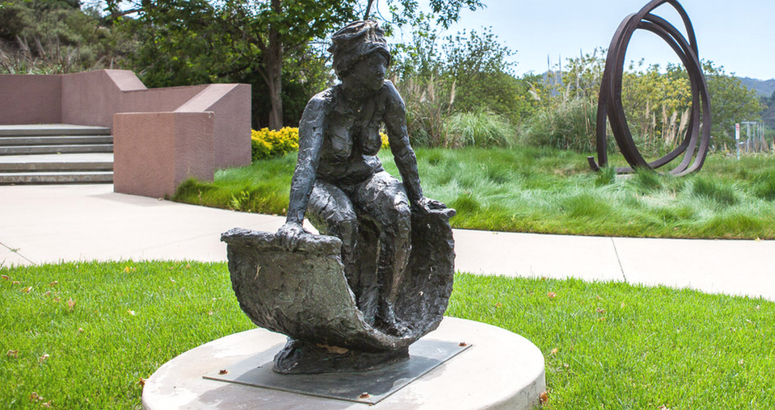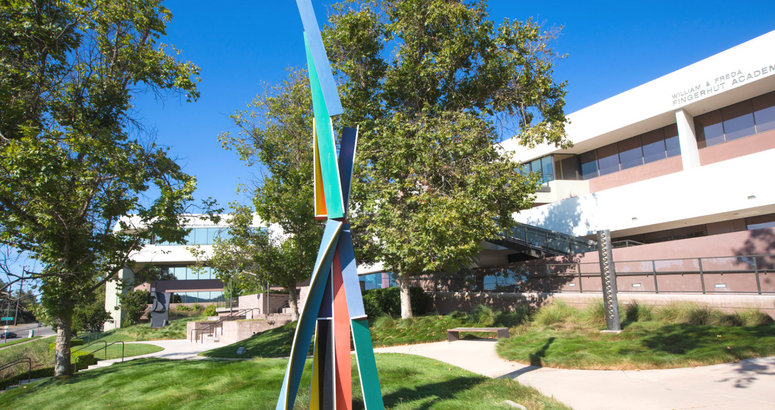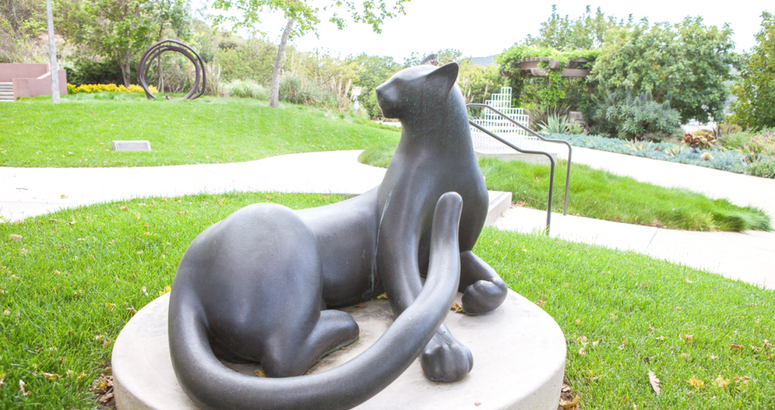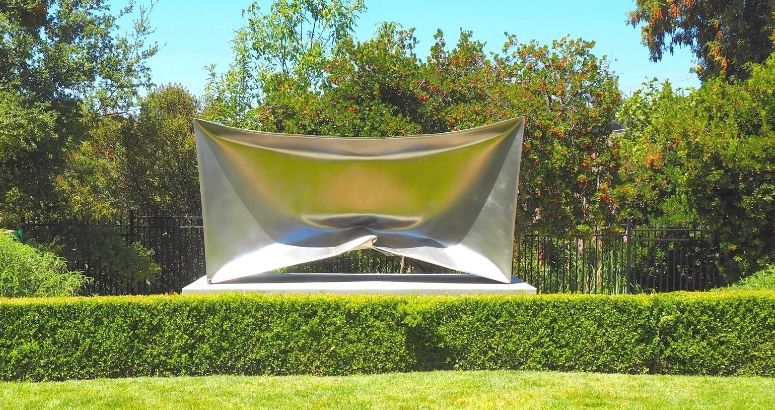The Sondra and Marvin Smalley Sculpture Garden at AJU represents a continued love for family tradition and the pursuit of education. This beautiful garden was dedicated on September 13, 1981 and contains a collection of museum-quality works of art, by artists who have achieved pre-eminence in that same time period. The dynamic and growing sculpture collection provides a unique environment for students and campus visitors to reflect, study, and discuss as they enjoy the collaboration of art and nature.
-
Ewerdt Hilgemann - Three of a Kind
Ewerdt Hilgemann
THREE OF A KIND, 2017 (Horizontal #1)
Stainless steel120 1/8 x 59 7/8 x 29 7/8 in.
Known for his implosion sculptures, which collapse geometric shapes on steel, Ewerdt Hilgemann has been experimenting with natural forces and forms in public spaces since his early training in Germany. Developed in the early 1980's, Hilgemann’s “implosion” process begins by fabricating perfect, geometrically pure stainless steel forms, which are meticulously welded and polished to satin gloss.
The series Three of a Kind includes three identical parallelepipeds, that after being imploded would be positioned in different ways. The Sondra and Marvin Smalley Sculpture Garden features an imploded form lying down on its base. “In an abstract way,” says the artist, “I believe they are symbolical of people’s visons on life. As human beings we are (almost) identical, yet we group and present ourselves differently, believing that makes the difference. As a German born artist, it is a great honor to be represented in such important surroundings, where intelligent people meet and visions on life are formed.”
Donors: Sondra and Marvin Smalley
-
Fletcher Benton - Balanced/Unbalanced “Wedge/Arc”
Fletcher Benton
Balanced/Unbalanced “Wedge/Arc”
1983
Fletcher Benton is known for his kinetic sculptures, which are sculptures that move. But, he began his career as an abstract painter in the 1950s and 1960s. Frustrated with the limitations of paint on canvas, he began work on movement with geometric pattern pieces and boxes which he was familiar with from his work in commercial signs. This was at the very beginning of the kinetic movement, and Benton worked largely in isolation, not aware of the other efforts of kinetic artists. The early works were more concerned with change, rather than movement. The pieces were really more like three-dimensional paintings. Full three-dimensional sculptures designed to be viewed from all angles came later and the movement of the pieces became less prevalent in his later works. In the late 1970s, he abandoned kinetic art, switching to a more traditional bronze and steel.
Donors – Shelley and Carol Appel
-
Fletcher Benton - Folded Circle Broken Line
Fletcher Benton
Folded Circle Broken Line
1993
Fletcher Benton was born in Jackson, Ohio in 1931 and began studying art at a very young age. At the age of 14 he held his first exhibition out of his own sign shop. Benton explored various different museums but in 1978 finally settled into working with welded steel. In 1979 the American Academy and Institute of Arts and Letters awarded Benton for his outstanding contribution to sculpture.
Donors – Gloria and Jerry Lushing
-
Anthony Caro - The Bather
Anthony Caro
The Bather
Bronze
1987
Anthony Caro, born in London, England in 1924 received his Master's degree in engineering at Cambridge University in 1944. He shifted his passion to the arts and began experimenting with human figures in bronze. Best known for his abstract work after the 1950s, his focus was the use of the construction “I-beam” which he most frequently uses in his sculptures.
Donors – Purchased with funds from the Sculptures Ball
-
Aldo Casanova - “Juncture”
Aldo Casanova
“Juncture”
Bronze
1965
Aldo Casanova was born in 1929 in San Francisco and received his PhD from Ohio State University in 1957. He has been an Assistant Professor of Art at Antioch College in Ohio and also Scripps College in California, as well as an Assistant Professor in Sculpture at Temple University. He demands that his sculptures capture the essence of individuality and power. This bronze column standing 9 feet high employs the ancient oriental Yin-Yang as the predominant element in its structure. His bronze totems command all of our attention because of their intrinsic nature and distinctive character. “My sculpture attempts to convey the immutable presence of the life force which some call God.”
Donors – Honey and Julius Karosen
-
Charles Ginnever - Echo
Charles Ginnever
Echo
Bronze with Patina
1986
Charles Ginnever was born in 1931 in San Mateo, California. He was drawn to sculpture at a very early age. With his commitment to art he began many years of study and travel throughout France and Italy. Upon his return, he earned his degree at the California School of Fine Arts in San Francisco and an MFA at Cornell University. His sculptures are visually startling and seem to defy gravity as they soar with sheets of folded steel.
Donors – Carol and Shelly Appel
-
Edward Lee Hendricks - XVII
Edward Lee Hendricks
XVII
1988
After receiving his Master of Fine Arts in 1976, Edward Lee Hendricks started working as a sculptor. Over the past 30 years, he has had over 41 person exhibitions in New York at the Alexander F. Milliken and Louis K. Meisel Galleries. His work is in the collections of over 25 corporations and government agencies. He currently lives and works in a 10,000 square ft. studio/residence compound in Houston, Texas.
Donors – Anette and Leonard Shapiro
-
Jenny Holzer - Action Causes More Trouble
Jenny Holzer
Action Causes More Trouble
Marble
1988
Jenny Holzer was born in Gallipolis, Ohio, in 1950. Holzer completed her undergraduate work at Ohio University and took graduate courses at Rhode Island School of Design. She experimented with public art, focusing on language and its inscription on various objects. Holzer’s work questions the relationship of art to its role in society. Her utilization of language on stone benches, painted signs and billboards seeks public response.
Donors – Nancy Epstein and Sondra and Marvin Smalley
-
Sol Lewitt - Spiral 123456789
Sol Lewitt
Spiral 123456789
Epoxy on Aluminum
1980
Sol Lewitt was born in 1929 in Hartford, Connecticut. He attended Syracuse University and taught at several universities including the Museum of Modern Art School, Cooper Union, The School of Visual Arts and NYU. He is best known for his work with geometric designs on all possible permutations on a grid. He believes that the most important part of art is in the process, not in the outcome. He does not think the way viewers perceive art is as meaningful as the thought that went into it. His work is found in most major museums throughout the world.
Donor – Marcia Weisman
-
Gwynn Murrill - Big Twisting Cheetah
Gwynn Murrill
Big Twisting Cheetah
Bronze
2009
Born in Michigan, Gwynn Murrill, an LA sculptor, has for decades portrayed life size tigers, cougars, cats, dogs, eagles and deer with the dignity of ancient Egyptian statuary and the refined elegance of early modernism. Murrill relies on photographs and memories of the rare glimpses she’s had of her wild subjects. Her work has a cool, smooth simplified spirit; her figures are both timeless and contemporary. She is the only living female artist whose work is represented in the Norton Simon Museum’s Sculpture Garden in Pasadena.
Donor – Sondra and Marvin Smalley
-
George Rickey - Two Open Triangles Up Gyratory
George Rickey
Two Open Triangles Up Gyratory
Stainless Steel
1983
Born in 1907 in Southbend, Indiana, George Rickey graduated with a B.A. in Modern History from Balliol College in Oxford, England. Rickey went on to complete an art and drawing study in Oxford as well as Paris, France. His works are classified in the realm of constructivism and kinetic sculpture using pointed metal beams, light reflecting metal strips and rotors. Recognition of his work followed in the 1960s as his work increased in size and experimentation, producing “fluid mastery.” His work as an artist is rooted in the capturing of time and movement with his sculptures. This sculpture was dedicated to the memory of the holocaust and is a reminder of the darkest hour in the history of the Jewish people.
Donors – Yvette Fierstein, Bobbie and George Horn, Niki and Michael Horwitch, Ginny and Arthur Kahn, Marcia and Howard Koff, Lenore and Ronald Lopaty, Bert and Harry Maron, Lois and Richard Neiter, Judy and Carl Scholsberg, Robert Schuster, and Louis Schuster
-
Bernar Venet - Undetermined Line
Bernar Venet
Undetermined Line
Steel
1991
Born in 1941 in France, Venet wrote and taught “Art and the Theory of Art” at the Sorbonne in 1971. He feels strongly in that contemporary art is not held to have truly artistic value unless it advances the idea of art. This piece, “Undetermined Line” is part of a large body of work that began in 1975. This dynamic steel line swirls into space. For Venet, line is the “heart of the idea” which was at once a mathematical symbol, the foundation of art, and a metaphysical idea. Venet does not design his sculptures in advance, but gives the straight bars of steel their undetermined form at the work site.
Donors – Patrons: Evelyn Alschuler and Susan Alschuler, Joan and Pearl Borinstein, Gloria and Peter Gold, Marlene and Sandy Loucheim, Marcia and Richard Schulman, Toni Sherman, Judy and Donald Simon, Sondra and Marvin Smalley, Ralyn and Nathan Wolfstein. “Friends of the Smalley Garden” – Carol and Sheldon Appel, Sharleen and Martin Cohen, Bonnie and Fred Glantz, Bobbie and George Horn, Ronnie and Harold Schwartz.
-
Jay Willis - Sempere Fidelis
Jay Willis
Sempere Fidelis
Anodized and Painted Aluminum
1984
Jay Willis begins a piece by building small maquettes of plexiglass in order to work out his compositions and to study the actual physical balance of the sculptures before he fabricates them in aluminum. The colors he chooses alternate between segments and establish a rhythmical beat. The elements are screwed and welded together to form a shape that has an upward direction showcasing an open, vertical structure.
Donor – Sondra and Marvin Smalley





